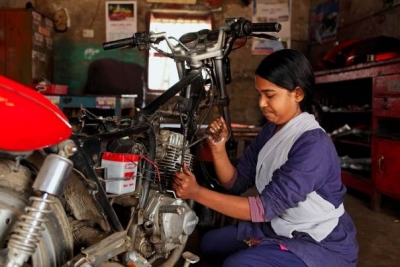
In the Media (61)
PSDF joins hands with BRAC
Punjab Skills Development Fund (PSDF) has joined hands with BRAC Pakistan, one of the largest non-governmental international development organizations in community health sector in the world which is based in Bangladesh.
PSDF Chief Operating Officer Ali Akbar Bosan and BRAC’s country representative& CEO Muzaffar-ud-Din signed the contract here.
Under the project, BRAC Pakistan will train 720 mature trainers who will impart training to 48,000 LHWs across the Punjab.
With improved skills, these LHWs would create awareness in community to improve health conditions at tehsil level, take active role to improve maternal, newborn and child health issues, help government to reduce child mortality rate and contribute in family planning services. Read More
Workers deserve better protection
The government should establish a strong legal protection and permanent framework to ensure adequate compensation for the victims of factory disasters, experts said yesterday. They spoke at a seminar in the capital's Spectra Convention Hall, organised by Brac, on the eve of the third anniversary of the Rana Plaza tragedy. Three years ago, on April 24, the Rana Plaza building collapsed, crushing workers underneath and drawing the world's attention to the safety concerns. The country lost at least 1,136 lives, and 2,438 were injured and scarred forever. Read more
The skilled girl effect: Worth more than the US and Chinese economies put together
A computer whirs to life in a small shop in Bangladesh’s chaotic capital Dhaka. Outside rickshaw drivers bargain for fares and street sellers call out the day’s fish prices. The phone rings. Hasna Hena, 15, takes the call in one hand, her other flying over the track pad to open Photoshop. It’s another new client needing a poster design. read more
Closing the Gender Gap: Lessons from Africa
We hear that girls in Africa don’t have the same opportunities as boys to get a decent education, that discrimination is shutting women out of the jobs and assets they need to provide a better standard of living for their families, that the benefits of economic growth are being wiped out because women are having too many children, and that thousands of women are dying in childbirth because they don’t have access to basic healthcare.
While all of these things are true, they also hide something that you rarely hear – that Africa has been making significant progress and even has a thing or two to teach the rest of the world. read more
Primary Schools in Bangladesh to Go Digital, Reaching 20 Million Students
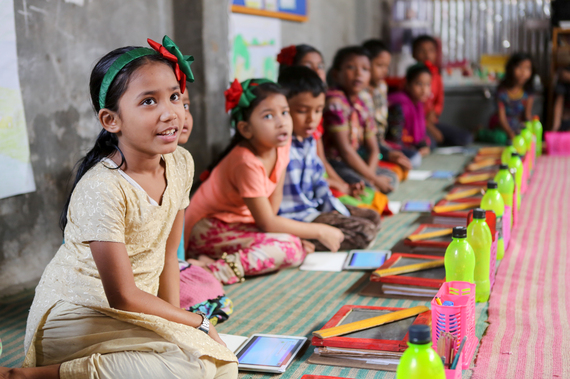
A Huffington Post article
By Zunaid Ahmed Palak and Safiqul Islam
The Bangladesh Prime Minister this week launched the latest addition to the country's digital curriculum to reach 20 million primary school students, continuing to revolutionise one of the most under-resourced education systems in South Asia.
As governments worldwide scramble to cultivate a generation of tech-savvy children, Bangladesh is continuing to push the boundaries of digital learning through interactive multimedia content. Even in the remotest corners of the country, the newest generation will now be using computers from their first year of school.
On 14 February, Prime Minister Sheikh Hasina launched interactive lessons for Grade 1-3, a joint initiative by the Government of Bangladesh, BRAC and Save the Children in response to the success of content previously developed by BRAC for Grade 6-10. By mid-2016, interactive lessons for Grade 1-10 (primary, junior and secondary education) will be accessible online on any device.
"Getting tech-based education to every corner of the country is a high priority of the government. Digital content contains lessons for all of us; it makes us all into teachers and we all become students," said the Prime Minister.
The 'tab school' in the slum
Korail, one of the largest slums in Dhaka, the capital of Bangladesh, is home to an estimated 40,000 people. It is never quiet. There is one building that has recently become particularly loud though. It is a rough tin shed, which rings with the sound of students laughing, talking, and singing their multiplication tables, along with animated voices for hours every day.
The shed, one of tens of thousands of schools run by BRAC, is known as the 'tab school'. In selected schools, BRAC has already started using tablets to access interactive multimedia digital learning content. Nur Nahar, the teacher in the school, laughs when she explains that her job is not only teaching, but also being taught. Her classes now revolve around digital media, which, prior to their introduction in her classroom, she had never even seen before.
"Digital content makes learning happen much faster," Ms Nahar said. "I have never seen many things in the world, and I never will. My students definitely have not either, but now they can see anything in the world in my class. Many topics, like mathematics and science, are hard to explain using just text. With pictures and videos, I have lots of new ways to show them why things happen and how. I had never heard of a tablet before this class. I was scared to use it but now I use it every day to explain things."
"Children are coming to school earlier and there are fewer students dropping out," she added. "Since this programme began, learning does not stop when class ends. It continues, every day, for so many more people than just my students. Children go home and show their families and everyone they know what they've learned on whatever device they can find. Every morning they come back knowing more than what I taught them so I have to work much harder than before to keep up."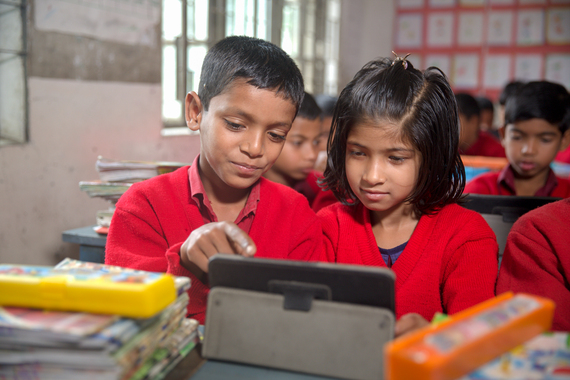
A gender-responsive, modern, secular curriculum for Digital Bangladesh
Digitising the national curriculum is acting as an impetus for reviewing and updating content. As lessons go online, a team of educators, policymakers and child psychologists ensure that all content is age-appropriate and children can identify with the animated characters.
In public schools, the content is being accessed on computers that the government has already placed in more than 5,500 digital classrooms across the country as part of its Digital Bangladesh initiative. In BRAC schools, where 1 million students are currently enrolled, the content is starting to be accessed on tablet devices.
Congratulating the government, BRAC founder and chairperson Sir Fazle Hasan Abed, KCMG said, "We introduced computer aided learning in 2005 to bring technology into the education sector. We appreciate the government taking it all over the country - it will change the future of education".
From Satkhira to Silicon Valley
The benefits of digital learning for Bangladesh's next generation will stretch far beyond the walls of Nur Nahar's classroom. In a country where students in developing countries like Bangladesh, the potential for information technology is huge. Approximately one in every four people live below the poverty line in Bangladesh, but more than 80 per cent use a mobile phone, and one in every three are online. The country is gearing up to move from manufacturing into the knowledge economy and IT is predicted to become its biggest source of foreign revenue. Bangladesh is already the home of, BKash, the service which Bill Gates himself now invests in, saying it will revolutionise banking for the poor. With students becoming familiar with computer-assisted learning from the first grade of primary school, and mobile-enabled devices rapidly becoming popular across the country, digital learning boasts a similar potential; to revolutionise education in Bangladesh. Every screen can become a space for families to experience animated learning.
As the online learning ecosystem is exploding universally, and Digital Bangladesh is bringing internet access to even the most remote corners of the country, students will be primed to tap into global opportunities. With global poverty being compounded by national inequality in almost every country, learner-centric education will build the confidence and creative mindset that students need to build their own path out of poverty or unemployment. The ultimate tool for leveling the playing field, there will be nothing stopping children in a flood-prone corner of rural Satkhira from learning computer programming to the same level of quality as children born in Silicon Valley.
Zunaid Ahmed Palak is the state minister, Ministry of ICT, Government of Bangladesh. He is the youngest minister in the history of Bangladesh.
Mobile money in Bangladesh
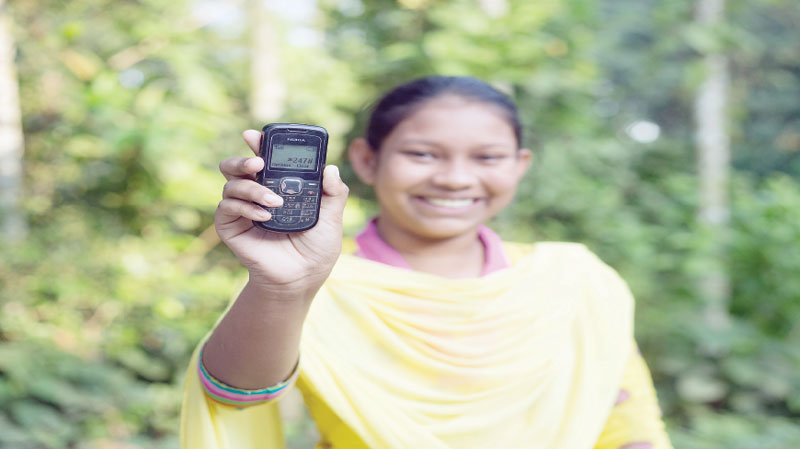
A Dhaka Tribune article by Hitoishi Chakma and Maria A May
In a recent Bloomberg interview, Bill Gates shares: “Banking is more fundamental than I realised. There have been attempts (at banking for the poor) by microfinance groups, cooperatives, but the transaction fees were always too high. Until we get those services down with very low fees and in digital mode, banking will only be for those who are better off.” In Bangladesh, where 95% of the population have access to mobile phones but only 20% have a formal bank account, the significance of such an opportunity for a banking revolution is even more pronounced. Indeed, since 2011, the Bill and Melinda Gates Foundation has made over $21 million in grants and equity investments in bKash.
Bangladesh has seen one of the world’s fastest growing mobile money ecosystems develop in the past two years. This growth has propelled bKash to become the second largest mobile money provider in the world, only behind Kenya’s mPesa. Ideally, this growth in digital money is also an opportunity for pro-poor financial service providers such as microfinance institutions to significantly expand financial access.
We are only to look at Kenya’s M-Shwari, that gives users instant access to short-term credit and secure savings for inspiration. As of 2015, one in five Kenyan adults are active M-Shwari customers. With the use of mobile money picking up here in Bangladesh, it is fast turning into an opportunity to ensure that everyone can enjoy the full benefits of banking products. Mobile money fees in Bangladesh, when comparing small transactions such as Tk400, are among the lowest in the world.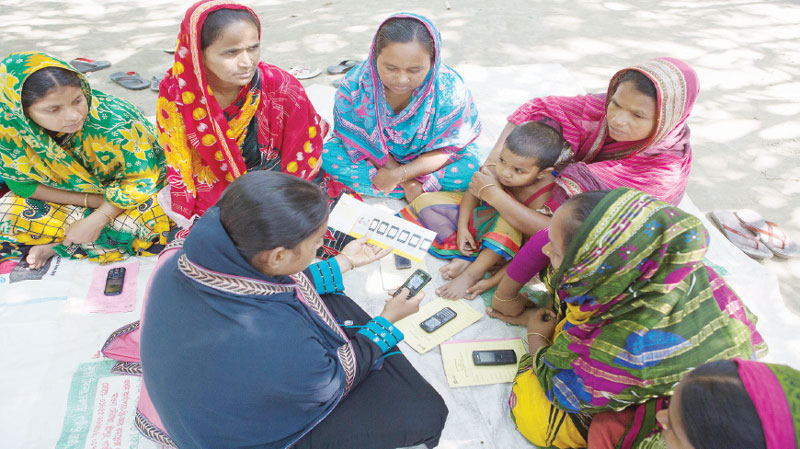
Yet for all the adoption of mobile money we have seen in Bangladesh, there remains one key segment of the population that has yet to embrace it - women, especially poor women living in rural areas. Despite the rich history of women’s participation in microfinance and savings groups, when it comes to mobile money, over 80 percent of the mobile money users turn out to be men. What explains this lag and what can we do about it? Especially when poor rural women can benefit immensely from access to such services that would enable easier remittances, create new savings mechanisms, and even make purchasing airtime hassle-free.
Since 2014, through the Gates Foundation-funded Innovation Fund for Mobile Money, BRAC has been piloting different projects in providing digital financial services for the poor. This experiment with mobile money aims to see how existing BRAC services can be transformed into more effective and valuable solutions for the poor. Over the past one-and-a-half years, these experiences ranged from providing digital microfinance in remote communities to offering flexible school fee payments that allows low-income parents to pay in small installments. Overall, the projects have targeted women and girls, focusing on their needs in products and financial education.
However, as we have found from the pilots, it is not easy for a rural woman to master mobile money. These women often report that they are satisfied with the ability to simply receive calls and may lack the basic numeracy skills required to navigate the mobile money menus. This has prompted us to begin providing financial education, where we provide basic numeracy skills and develop financial management skills. In places like remote Hatiya, where literacy levels are low, it can take three to six months of financial education before a woman feels confident carrying out her own transactions.
While this is a lot of work, it is easy to assume that women are lagging behind in adopting mobile money because of an information gap. Certainly, limited information and literacy create challenges, but in fact, the barriers to adoption go much deeper.
A recent exploration of the problem using human-centered design techniques solidified these convictions. One of the central comments heard repeatedly from women is that they do not identify themselves with becoming users of mobile money, which is the domain of the businessman. Additionally, many women lacked confidence in their ability to use the service preferring to use cash instead. This shows that, like most of us, they are present-biased and seek to avoid the immediate difficulties associated with learning to use the service even though it would bring them greater benefit in the future. By simply relying on agents their basic needs were being met and many commented on carrying out transactions with agents as “fine.” Fortunately, these issues can all be addressed, but not through traditional financial education. Instead, this requires more creativity from mobile money providers and NGOs on how they design their services.
What inspires BRAC the most is the increasing number of women from Hatiya to Panchargarh who, despite all of these issues, are now expert mobile money users, confidently buying airtime, making deposits into their savings accounts, and managing their remittances. Their needs superseded their unfamiliarity and fear of technology. Many received significant support from BRAC’s staff and/or local bKash agents, who they trust and can access as needed. Given the challenges of reading the English menu, many used rote memorisation through mnemonic techniques to make these transactions.
Ultimately, necessity drives innovation. Till date, despite the potential present, womens’ demand for mobile money in Bangladesh has not been activated. Reaching these women is a must, if a banking revolution is to be ignited for the poor through mobile money.
The original article can be found at: http://www.dhakatribune.com/feature/2016/feb/15/mobile-money-bangladesh#sthash.52aJVlqt.dpuf
The Story Behind the 2015 World Food Prize Laureate
When the non-profit BRAC was set up over 40 years ago, it was a temporary effort aimed at helping rural populations that had been affected by a devastating cyclone and civil war. Today, BRAC is one of the biggest NGOs in the world, and responsible for lifting 150 million people out of poverty. Farming First TV had the opportunity to interview BRAC’s Founder, Sir Fazle Hasan Abed at the Borlaug Dialogue in Iowa, where he was honoured as the 2015 World Food Prize Laureate, to find out the secrets of success behind the Bangladesh-based NGO.
For centuries, Bangladeshi farmers had faced a hunger season, known as monga. Sir Fazle told Farming First how giving farmers access to rice varieties that matured more quickly allowed a third crop, potatoes, to be planted in between the two rice growing seasons. “It was long assumed to be a part of the enduring fabric of rural life in northwest Bangladesh. But today, we are starting to see the disappearance of monga and, in many places it has gone completely,” he commented.
“We have…succeeded in disrupting a pattern of suffering that had prevailed for centuries”
Providing farmers with finance and access to markets in order to sell their produce, was a second strand of activity that BRAC undertook in order to help rural people prosper. Sir Fazle told us how he had seen that farmers in rural areas were not getting a fair price for their milk.
“I thought, if we could collect milk… refrigerate it, and transport it to Dhaka, we could easily pay (the farmer) 15 taka per litre — roughly twice what she was getting at that time — and still cover our costs. This led to the establishment of the BRAC Dairy enterprise.”
BRAC now operates several social enterprises, that are all focussed on providing high quality inputs and services for the poor. These businesses generate $150 million in profit each year, which is all directed into financing BRAC’s non-for profit work such as healthcare and education.
For more information on Sir Fazle Hasan Abed and BRAC’s work, visit the World Food Prizewebsite.
Bangladesh, Uganda and Tanzania - a new 4.7 million USD partnership with BRAC
21 December, 2015: As the importance of early learning gains support, there is a growing need to ensure that practice in the sector reflects this emphasis on whole child development and the skills and capacities children need to thrive. In light of this, the LEGO Foundation is pleased to announce a 3-year, 4.7 million USD partnership with BRAC focused on promoting the importance of learning through play in Bangladesh, Uganda and Tanzania.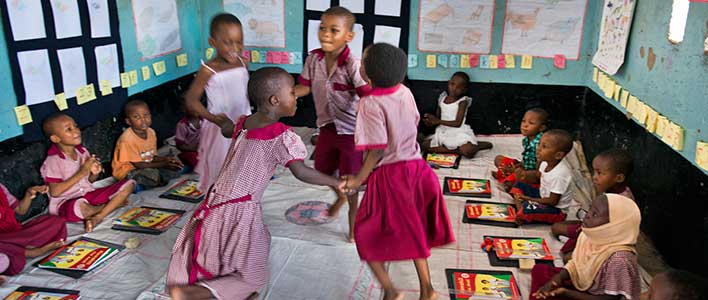
Photo by: Alison Wright/BRAC
Over the course of this 3-year commitment, we will jointly develop and pilot the Play Lab concept, which is a model for integrating play-based learning into the lives of young children between the ages of 3 and 5. We aim to educate and impact both children and their caregivers. Our approach to program design and development ensures that we are able to reach the most vulnerable children and their families.
With this pilot project we aim to launch 240 Play Labs for 7,200 children; train nearly 500 adolescent girls as play leaders, and educate parents on the importance and value of learning through play. Additionally, we commit to design environmentally sustainable play spaces for homes and communities that otherwise lack play spaces.
To stay up-to-date on play-based education, we will launch a global network of experts who will gather best practices on learning through play, develop curriculum and materials, and act as advocates for children's right to play.
The project will be monitored and evaluated, so that we are able to establish an evidence-based model of scalable Play Labs that exemplifies a low-cost, high-impact intervention capable preparing children to overcome future challenges.
This commitment strengthens the LEGO Foundation’s efforts in East Africa and marks our first major investment in learning through play in Asia.
Does Your Organization Actually Empower Women?

17 December, 2015
A NextBillion article by Emily Coppel and Tarini Mohan
INDEX TRACKS WOMEN’S INVOLVEMENT IN AGRICULTURE TO IMPROVE PROGRAMMING AND IMPACT
Faruque Ahmed, executive director of BRAC International, recently wrote for NextBillion about the need for women entrepreneurs to bolster economic recovery in post-Ebola West Africa. One of the most effective ways to counter the repercussions of Ebola and specifically address food scarcity and the destruction of agricultural value chains, he wrote, is to empower female farmers. Here, Tarini Mohan and Emily Coppel of BRAC write about a new scientific method has the potential to change the way NGOs develop empowerment programs for female farmers and dramatically improve outcomes in West Africa and beyond.
“Data not only measures progress, it inspires it. What gets measured gets done. Once you start measuring problems, people are more inclined to take action to fix them because nobody wants to end up at the bottom of a list of rankings.”
– U.S. Secretary of State Hillary Clinton, 2012
Women’s empowerment programs have surfaced as a key component of the international development agenda. Although many organizations working in international development make grandiose claims of their programs’ ability to empower women, with few tools available to actually measure empowerment, it is hard to tell if these claims are based on fact or whether they are an organizational appeal to funders.
Until recently, no major development agency had devised a mainstream method to track and measure changes in the level of women’s empowerment in any field, but particularly in agriculture, where it has significant potential to improve food security on a global scale.
WHY IN AGRICULTURE, SPECIFICALLY?
No fewer than 27 different studies have found that male farmers achieve higher yields than female farmers. The yield gap is as high as 25 percent. This is not because women are poor farmers. It is entirely explained by the severe constraints women face in accessing productive resources, such as land, seeds, fertilizer, pest control measures, extension advice and mechanical tools.
Empowering female farmers and enabling equal access to inputs could not only increase yields on their farms by 20-30 percent, but also put more resources in women’s hands, which would strengthen their voice within the household. Empowering women in agriculture is a “proven strategy for enhancing food security, nutrition, education and health of children,” according to the Food and Agriculture Organization. “And better-fed, healthier children learn better and become more productive citizens. The benefits would span generations and pay large dividends in the future.”
DOES A SOLUTION EXIST?
In March 2012, USAID, along with the International Food Policy Research Institute and the Oxford Poverty and Human Development Initiative, developed the Women’s Empowerment in Agriculture Index (WEAI) to track women’s involvement in agriculture. It monitors five domains of empowerment: decisions about agricultural production; access to and decision-making power about productive resources; control of income; leadership in the community; and women’s control of their time. A woman or man is considered empowered if (s)he has “adequate achievements” in four out of the five domains, or is empowered in some combination of weighted indicators that makes up 80 percent of the total adequacy score.
Practitioners can also look at the segment of women not empowered and identify in which of the five domains the problem lies. This helps practitioners to improve program design in a targeted way to better reach clients. Apart from the five domains, the WEAI also includes the Gender Parity Index, which compares the level of women’s empowerment to the level of men’s empowerment.
The most compelling feature of the WEAI is its international comparability. Women’s empowerment is by essence context-dependent; for example, how empowered a woman feels in society is largely driven by the socioeconomic, cultural and political features of that particular society. To address this, the WEAI was constructed after a review of hundreds of women’s empowerment indicators in more than 30 studies across several countries in subjects ranging from economics to psychology. The primary purpose of these indicators was international comparability and to construct an index that comes as close to universal applicability as possible.
WHAT DOES EMPOWERMENT MEAN?
The most accepted definition of empowerment – one that was developed by Naila Kabeer, professor of gender and development at London School of Economics and Political Science, is the expansion in people’s ability to make strategic life choices in a context where this ability was previously denied to them. Thus, empowerment arises from some state of disempowerment.
Currently, the majority of international development organizations use proxies to measure empowerment – such as a woman’s education level or employment status – rather than measuring empowerment itself. For example, claiming that a woman is empowered if she already has access to credit would not be correct for two reasons. First, the woman’s access to credit represents a static state, rather than a dynamic one, if the time period being studied is one in which she always had that access. Secondly, resources like access to credit can be thought of as “enabling factors,” or important inputs to foster a good environment for empowerment to take place, not as measures of empowerment itself.
CASE STUDY
BRAC, the world’s largest development organization, operates programs in agriculture aimed at empowering women and the poor by helping them to build secure livelihoods for themselves. Through our sustainable agriculture programs, millions of women have gained access to markets, resources and financial services. These women, by existing measures, have been empowered, but using a formal index like the WEAI would help BRAC and similar organizations improve their programming and impact.
BRAC fosters an enabling environment to achieve women’s empowerment. It does this by operating programs primarily in rural areas, to combat food insecurity, financial constraints, inadequate healthcare, education and vocational training of a large pool of youth, as well as by focusing programming on and targeting primarily women. Being a part of the rural community, BRAC tried to identify the real needs of the communities and what would allow them to flourish; it identified food insecurity and unemployment as the most pressing needs. BRAC is aiming for a multiplier effect by running a last-mile delivery system through female community agriculture promoters and agriculture input distribution.
BRAC helps secure female farmers’ livelihoods, thereby elevating women’s importance in the household through trainings, providing access to information on crop production, credit services through BRAC’s microfinance program, and encouraging use of high-quality inputs (disease-resistant seeds, fertilizers and pesticides) at an affordable cost.
BRAC, to date, has measured enabling factors to gauge women’s empowerment levels. Its results have been positive, showing that women who participate in its programs have greater control over their income from farming and increased access to financial services. However, BRAC and many other development and agriculture NGOs would benefit by adopting a more systematic way to measure women’s empowerment using tools like the WEAI. It would not only be a more accurate measure of empowerment, it would also help to improve program design and outcomes.
BRAC is giving serious thought to adopting the Women’s Empowerment in Agriculture Index.
TO ADOPT OR NOT TO ADOPT?
To some extent, women’s empowerment will always be an empirical question, but adoption of the Women’s Empowerment in Agriculture Index is a step in the right direction, as it maps out the sphere in which corrective action needs to be taken.
Adopting this index is not as simple as this article may make it sound. It is quite a time burden on staff, and may distract from the overall initiative. However, once use of the index becomes routine, it could become the very basis for the agriculture program of various organizations.
Leaving it behind
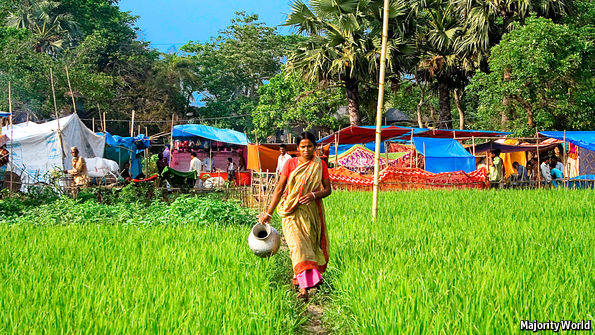
12 December, 2015
An Economist article
In a small hut overlooking a muddy river, a dozen women are trying to explain how they fell into destitution. After a few stories of husbands falling ill or vanishing, of ill-paid work drying up, of children sickening, of resorting to begging, almost all are crying. This is quite usual, says Sagarika Indu. BRAC, the large aid organisation she works for, has chosen these women and about 1.6m others since 2002 precisely because they are among the most desperate, ground-down people in one of the world’s poorest places.
But then something unexpected happens: the women invite your correspondent to visit again in a couple of years. Is this mere politeness or confidence in the future? It could be either—because they are very likely to be much better off by then.
Roughly 700m people are thought to live in extreme poverty, defined as getting by on less than $1.90 a day. That is huge progress: more than 1.9 billion lived on less than the equivalent amount in 1990. Yet the gains are uneven. Poverty has plummeted in China but declined more slowly in sub-Saharan Africa and South Asia. And the poor are diverse. Among them are a particularly desperate bunch: the “ultra-poor”, who routinely go hungry. In Bangladesh, most are landless, illiterate rural women with children.
In the 1990s it became clear that microfinance, then the most exciting tool in development economics, was not reaching the very poorest people, recalls Sir Fazle Abed, BRAC’s founder. Microlenders offer small loans at lower interest rates than moneylenders charge. Costs are kept down by assembling small groups of borrowers and encouraging them to exert pressure on each other to repay their loans. One reason the poorest were not borrowing, Sir Fazle says, was that other villagers viewed them as hopeless cases.
BRAC came up with a scheme to help the ultra-poor. It gives them a small stipend for food, followed by an asset such as a cow or a few goats, which they are expected to manage. Field workers visit weekly for the next two years, teaching recipients, for example, how to tell when a cow is in heat and how to get it inseminated. The aim is to help women “graduate” from extreme poverty to the normal kind—as Sir Fazle puts it, “to help them back into the mainstream of poor people”. Then, perhaps, they can start borrowing.
Later research showed that microfinance was not the cure-all that had been thought. But BRAC’s graduation programme proved highly effective. Large randomised controlled trials (explained in the next article) show that it makes people wealthier and raises their spending on food and durable goods. It works outside Bangladesh, too. A study published earlier this year in Science showed that similar programmes run by other NGOs boosted consumption in Ethiopia, Ghana, India, Pakistan and Peru, with the effects lasting at least a year after they ended. The only failure was in Honduras, where many of the chickens given as assets died.
Such programmes are pricey. In India and Bangladesh they cost more than $1,000 per household at purchasing power parity. In Peru, where field workers are better paid, the cost was $5,742. If they are to expand—and about 30 countries are mulling or testing them—two questions must be answered. Do the recipients stay out of deep poverty or slip back? And how exactly do they work?
The results of two big research projects, presented at a conference in London on December 9th, provided some powerful hints. Esther Duflo of the Massachusetts Institute of Technology showed that women who were offered cows, goats and intensive training in the Indian state of West Bengal not only did not fall back into indigent poverty but kept climbing out of it. Seven years after the programme began their average monthly consumption was almost one-third higher than it had been after two years. The gap between these women and the untreated control group grew much wider.
Other research explains why. Oriana Bandiera and Robin Burgess, both of the London School of Economics, and four others followed 21,000 people in 1,309 Bangladeshi villages. They tracked ultra-poor women, some of whom were randomly assigned to the graduation programme, and also kept an eye on everyone else. Of the 21,000, only 6,700 were deeply poor at the start. The rest were a mixture of fairly poor, middle class and upper class (by rural Bangladeshi standards, that is: they do not swan around in Hermès).
The poorest women, it turned out, did far more hours of income-generating work: 991 per year on average, compared with 553 for middle-class ones. Yet they packed them into fewer days: the average ultra-poor woman worked for only 252 days a year, compared with 302 for a middle-class woman and 325 for an upper-class one.
The reason is that they toil mostly as domestic servants and in the fields—and casual agricultural work is seasonal. During planting and harvest they work extremely hard; the rest of the year they do little. Better-off women usually rear livestock, which is not only steady work but pays about twice as much per hour. When the poorest women are given cows, they quickly fill their idle time (see chart). They also cut back a little on domestic and field labour.
This is a clue to why microfinance does not reach the poorest. Ms Bandiera and Mr Burgess estimate that the internal rate of return for ultra-poor women going through the graduation programme is between 16% and 23% per year, depending on the assumed opportunity cost of time. That is roughly the interest rate on a microloan. So it ought to be worthwhile for a poor woman to borrow money to buy a cow (and returns would be even higher if they did not require the training BRAC’s field workers provide). The problem is that no microlender would lend them that much.
Some questions remain. The big one is whether the schemes would work in cities. Slum-dwellers are seldom as indigent as agricultural labourers, but they can still get trapped in poverty, and cannot be rescued by gifts of cows. Urban populations are growing so much faster than rural ones that this question is becoming urgent. Another is whether the programme can be run more cheaply. BRAC will soon test sending field workers to visit each recipient once a fortnight instead of once a week.
Their words are heard
For all the advances in research, some things defy measurement. Near Bonabalia, another group of women, recent graduates of the ultra-poor programme, have gathered. What is striking is not so much their greater wealth (reflected in their finer saris and mobile phones) but the way they stand straighter, and their direct looks. Their relatives have started talking to them. Asked to explain how their lives have changed, one of the first things they say is that they now get invited to weddings.
Join the world’s biggest family

